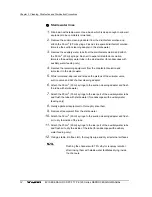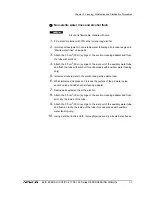
Chapter 5 Storage and Disposal
67
EVIS EXERA GIF/CF/PCF TYPE 160 Series REPROCESSING MANUAL
Chapter 5 Storage and Disposal
5.1
Storage
• The storage cabinet must be clean, dry, well ventilated and
maintained at ambient temperature. Storing the endoscope in
direct sunlight, at high temperatures, in high humidity or
exposed to X-rays and ultraviolet-rays may damage the
endoscope or present an infection control risk.
• Prior to storage, detach all removable parts from the
endoscope. It will allow air to circulate through the internal
lumens of the endoscope and will assist drying.
• Prior to storage, uncap the auxiliary water inlet. This will
allow air to circulate through the internal lumen of the
endoscope and will assist drying (for endoscopes with
auxiliary water feeding only).
• Do not store the endoscope in the carrying case. Use the
carrying case only for shipping the endoscope. Routinely
storing the endoscope in a humid, non-ventilated
environment such as the carrying case may present an
infection control risk.
• When storing an endoscope that has the flexibility
adjustment mechanism, make sure that the insertion tube is
set to the softest condition (indicated by the “
” mark on the
flexibility adjustment ring). If the endoscope is stored while
the insertion tube is too stiff, the endoscope may be
damaged (for endoscopes with flexibility adjustment only).
1.
Before storage of a high-level disinfected endoscope, thoroughly dry all
parts of the endoscope (especially all internal lumens, the distal end, lenses
and electrical contacts) and all accessories.
2.
Using a cotton swab moistened with 70% ethyl or isopropyl alcohol,
carefully wipe the lenses at the distal end.
3.
If the endoscope has the flexibility adjustment mechanism, make sure that
the insertion tube is set to the softest condition by aligning the “
” mark on
the flexibility adjustment ring with the “
” mark at the bottom of the grip
section (for endoscopes with flexibility adjustment only).




































